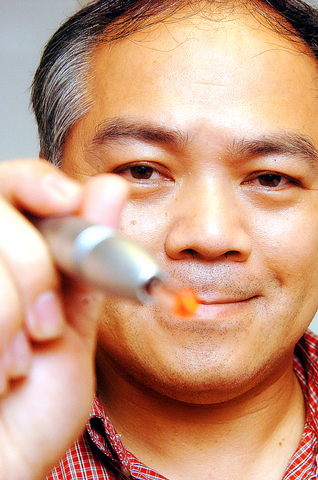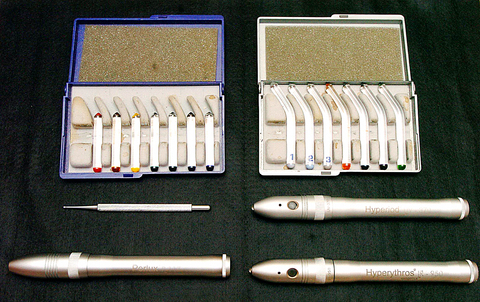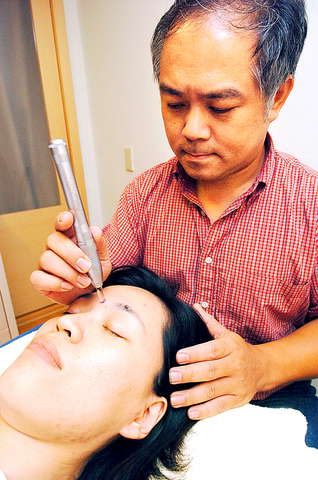While traditional Chinese healing methods will undoubtedly continue to be popular, many in Taiwan are also turning to hybrid holistic treatments such as colorpuncture, which combines the theories of age-old Chinese medicine with modern technology.
Holistic healing is not a new concept, but over the past five years there has been a marked rise in the popularity in Taiwan of such alternative methods of treatment.
Such practices have been ridiculed by the mainstream medical profession. Those who study holistic treatments may be presented with a certificate on completion of their studies but such paperwork is next to worthless in Taiwan.

The government acknowledges practitioners of traditional Chinese medicine even though there is no standardized examination system, but it remains hesitant to recognize the healing abilities of non-medicinal and, dare we say it, new-age treatments. Because of this, practitioners of holistic healing like Ben Chen (
"People are now more open to new types of treatments but there are still some stigmas surrounding what we do," Chen said. "We don't like to advertise because we are not officially recognized. And although large numbers of people are turning to alternative forms of medical treatments, a section of society still treats us like quacks."
To counter these snake oil claims, alternative therapists like Chen argue that conventional medicines do not address the needs of the patient as a whole. Non-medical philosophies are, according to Chen, not only safer, but because they incorporate the physical, mental, and spiritual aspects of the patients' problems, they are also more in tune with the natural balance of the human body.

"Sure, there's nothing wrong with going to the hospital if you have backache, but the medicine that you are prescribed won't deal with the crux of the problem," said Chen. "The pain will be gone, but the underlying cause of the pain will still be there."
For Chen, who is a qualified acupuncturist, holistic healing is both a profession and a form of relaxation. He still practices traditional Chinese medicine, but over the past couple of years he's become immersed in the world of colorpuncture; a form of treatment that is based on acupuncture but was developed by German naturopath Peter Mandel in the late 1970s.
Although many practitioners of colorpuncture in Taiwan have backgrounds in traditional medicine, Chen was initially skeptical of the process when it was introduced to him four years ago. A case of diarrhea and stomach cramps, however, would change his views toward treatment by light.

PHOTOS: WANG MIN-WEI
"I was at work and felt ill. A friend suggested that I try colorpuncture and I thought that's never going to work," he said. "About 30 minutes after I was treated I felt a bit better. The cramps had stopped and I didn't need to go the bathroom. I never believed it would work, let alone work that well."
Like acupuncture, colorpuncture is based on the principle that a balanced flow of chi through the meridian (which resembles an electrical wiring circuit for the body) can ensure good health and general well-being. Unlike needles, however, the lights used in colorpuncture do not penetrate the skin but instead send information into the body's meridian system in the form of light frequencies.
While this is, according to long-term holistic healing devotee Mary Lee (李瑪琍), one of the reasons that colorpuncture has become so popular in recent years, colorpuncture treatment can be a lengthy process. Sessions can range from between 10 to 90 minutes depending on the type of treatment.
"It's non-intrusive in the sense that there are no needles entering the skin, but to be treated properly by
colorpuncture patients must be willing to talk to the practitioners," she said.
"Successful treatment relies on mental and emotional openness. If patients don't feel at ease talking about their emotions, feelings and way of life, then they might as well take pills. Colorpuncture after all is a way to find the cause of the problem and not simply alleviate the immediate pain."
In order to radiate the various frequencies needed to delve into patients' problems, colorpuncturists employ a small handheld torch-like instrument into which a colored glass tip is inserted. The tips are either placed directly onto acupoints or held a short distance above depending on the type of treatment the patient is receiving. Each colored glass tip has its own frequency and the various colors are used to treat different types of ailments.
The basic colors used in colorpuncture are red to physically stimulate, orange for emotional stimulation, yellow for nerve systems, green to ease pain, turquoise to elevate the subconscious, blue to sooth and violet to arouse spiritual emotions.
Along with the basic colors colorpuncturists also employ ultraviolet and infrared lights to stimulate emotional and physical responses.
"I know people are dismissive of all the psycho stuff, but you can feel the energy emitting from the light," said long-term expat and student of colorpuncture, Mana Kalama. "It's based on the relationship between emotions and meridians and as such enables [the patient] to delve into their subconscious. The energy [from the light] has been so strong on occasions that I've had to hold the torch two feet (0.6m) away. It really can be that powerful."
Color therapy has been used as method of healing for thousand of years. Many of the healing systems of ancient cultures were based on the realization that certain colors affect both the human mind and body in certain ways and that light and color can cure both mental and physical problems.
Chen and his fellow colorpuncturists firmly believe, however, that the painless non intrusive form of holistic healing can one day become as widely accepted in Taiwan as the 3,000 year-old art of acupuncture.
"Colorpuncture can be used to both supplement acupuncture treatments and as a standalone treatment," he said. "Like acupuncture [colorpuncture] is based on the reduction or buildup of chi in relation to the meridians. They have so much in common that I can't see why colorpuncture can't one day become as widely popular as acupuncture."
One of the first to realize the possibilities of teaching colorpuncture in Taiwan, holistic healing devotee Mary Lee was introduced to colorpuncture whilst living in India. She has been running Taiwan's sole colorpuncture training center for the past eight years.
In that time hundreds of people have been taught how to heal through colorpuncture. "Initially we introduced colorpuncture as a way to alleviate pain and we had a lot of dentists enrolling in classes," said Lee. "I don't know how many of the students have begun to practice colorpuncture full-time, but I'd say that there must be at least a hundred places in Taiwan where you can receive colorpuncture treatment now."
In the three decades in which colorpuncture has been employed as an alternative form of therapy it has been found to be a safe and effective form of treatment. Individual reactions to light on the body are different, however, and overexposure to bright full-spectrum light can -- if not employed under the supervision of a qualified colorpuncturist -- ?have some adverse side affects. These can include eye irritation, headaches and even insomnia.
"It might appear harmless, but you do have to be careful," said Kalama. "You can't simply go out and purchase the equipment and begin pointing light at people willy-nilly. That could be quite dangerous."

Exceptions to the rule are sometimes revealing. For a brief few years, there was an emerging ideological split between the Democratic Progressive Party (DPP) and Chinese Nationalist Party (KMT) that appeared to be pushing the DPP in a direction that would be considered more liberal, and the KMT more conservative. In the previous column, “The KMT-DPP’s bureaucrat-led developmental state” (Dec. 11, page 12), we examined how Taiwan’s democratic system developed, and how both the two main parties largely accepted a similar consensus on how Taiwan should be run domestically and did not split along the left-right lines more familiar in

This month the government ordered a one-year block of Xiaohongshu (小紅書) or Rednote, a Chinese social media platform with more than 3 million users in Taiwan. The government pointed to widespread fraud activity on the platform, along with cybersecurity failures. Officials said that they had reached out to the company and asked it to change. However, they received no response. The pro-China parties, the Chinese Nationalist Party (KMT) and Taiwan People’s Party (TPP), immediately swung into action, denouncing the ban as an attack on free speech. This “free speech” claim was then echoed by the People’s Republic of China (PRC),

As I finally slid into the warm embrace of the hot, clifftop pool, it was a serene moment of reflection. The sound of the river reflected off the cave walls, the white of our camping lights reflected off the dark, shimmering surface of the water, and I reflected on how fortunate I was to be here. After all, the beautiful walk through narrow canyons that had brought us here had been inaccessible for five years — and will be again soon. The day had started at the Huisun Forest Area (惠蓀林場), at the end of Nantou County Route 80, north and east

Specialty sandwiches loaded with the contents of an entire charcuterie board, overflowing with sauces, creams and all manner of creative add-ons, is perhaps one of the biggest global food trends of this year. From London to New York, lines form down the block for mortadella, burrata, pistachio and more stuffed between slices of fresh sourdough, rye or focaccia. To try the trend in Taipei, Munchies Mafia is for sure the spot — could this be the best sandwich in town? Carlos from Spain and Sergio from Mexico opened this spot just seven months ago. The two met working in the